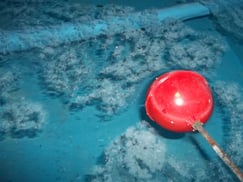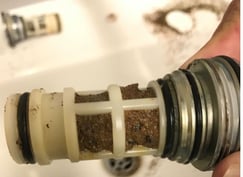 When considering a suitable and sufficient rationale for the undertaking of disinfection works it’s initially important to ensure that the approach taken is ‘proportionate to risk’
When considering a suitable and sufficient rationale for the undertaking of disinfection works it’s initially important to ensure that the approach taken is ‘proportionate to risk’
This helps to ensure the microbiological safety of the water whilst mitigating overdosing / treating that may otherwise needlessly impact upon the integrity of the treated system – considering the oxidative potential of some chemistry disinfectants and that HTM04-01 Part A Chapter 4 (note) details that any biocidal treatment should not adversely affect the materials of construction.
HSG274 and BS8558
HSG 274 Part 2 pp.42-44 provides prescriptive details of when and how to carry out cleaning and disinfection works referencing BS8558. Although, it is worthy of note that the BS8558:2015 revision included a new British Standards ‘published document’ titled ‘PD 855468:2015 guide to flushing and disinfection of services supplying water for domestic use within buildings’ which should be referred too for the correct process.
Such a process does necessitate the completion of a risk assessment / method statement (RAMS) prior to the commencement of any cleaning and disinfection works, whereby RAMS are informed by risk assessments which in turn identify hazards associated with the works to be completed (access / egress, chemicals to be used, safe working at height etc.).
HSG274 and HTM04-01
Whilst the ‘predominant’ non-healthcare guidance notes (HSG 274) reference the health care guidance (HTM04-01) for completeness, HSG 274 is understandably Legionella-centric, therefore whilst it may be prudent for health estates professionals undertaking requisite cleaning and disinfection works to follow PD 855468:2015, careful consideration should also be given to HTM04-01 when drafting a microbiological sampling strategy – to help demonstrate that completed remedial works have been effective. This may entail selecting for total viable count (TVC) as well as Pseudomonas aeruginosa and Legionella species (spp) – if previously recovered utilising British Standards 7592 – Legionella and 8554 – hot and cold water system sampling respectively (to help ensure that the appropriate ‘sampling technique’ is employed when undertaking such works).
HTM04-01 Part B Figure 4 Action levels following Legionella sampling in hot and cold water systems. Example 1 – provides prescriptive guidance action when samples test positive for Legionella from either pre or post flush samples thus delineating between potential ‘local’ or ‘systemic’ contamination.
Sampling Methodology
Such sampling methodology will undoubtedly have a significant bearing upon the type and complexity of remedial works undertaken and vice versa. For example, should the minority of samples return positive for the target organism which have been recovered from ‘pre flush’ samples (rather than post flush) then this may indicate local contamination that may be easily remedied by cleaning, flushing / water draw-off and thermal disinfection (pasteurisation). Conversely, should the majority of samples return positive following ‘post flush’ sampling analyses then this may indicate a systemic issue which may necessitate cleaning and the use of approved supplementary control strategies (chemistries such as chlorine). The complexity of corrective / remedial works undertaken will also impact upon sampling methodology… when disinfecting a treated ‘system’ with an oxidising biocide (chlorine) this entails a different sampling process to sampling from a treated asset (local contamination).
upon the type and complexity of remedial works undertaken and vice versa. For example, should the minority of samples return positive for the target organism which have been recovered from ‘pre flush’ samples (rather than post flush) then this may indicate local contamination that may be easily remedied by cleaning, flushing / water draw-off and thermal disinfection (pasteurisation). Conversely, should the majority of samples return positive following ‘post flush’ sampling analyses then this may indicate a systemic issue which may necessitate cleaning and the use of approved supplementary control strategies (chemistries such as chlorine). The complexity of corrective / remedial works undertaken will also impact upon sampling methodology… when disinfecting a treated ‘system’ with an oxidising biocide (chlorine) this entails a different sampling process to sampling from a treated asset (local contamination).
In either case, it’s essential to ensure that following the completion of corrective works requiring the use of halogen biocides, that these  chemistries are adequately flushed from water systems or assets prior to any resampling undertaken. Moreover, both the HTM04-01 and HSG 274 capture that for any microbiological sampling to be undertaken following such disinfection (when remediating and or commissioning new water systems), samples should be taken between 2-7 days after the system has been refilled – to mitigate the risk of receiving false negative sample results.
chemistries are adequately flushed from water systems or assets prior to any resampling undertaken. Moreover, both the HTM04-01 and HSG 274 capture that for any microbiological sampling to be undertaken following such disinfection (when remediating and or commissioning new water systems), samples should be taken between 2-7 days after the system has been refilled – to mitigate the risk of receiving false negative sample results.
In summation, adopting a proportionate approach to risk when remediating affected water systems – utilising the aforementioned guidance notes to inform a cleaning, disinfection and sampling plan undoubtedly represents a robust and sustainable approach. Conversely, in the event of disproportionate action taken then this may impact upon the efficacy of the strategy (microbiological quality/safety of the water system) and the integrity of the treated system… in the event of ‘overdosing’, which may also encourage the accumulation of corrosion scale – known to be a source of nutrients for waterborne bacteria / pathogens…
Further reading> Legionella sampling: Part 1 - What's your sampling strategy?
Feel free to reach out if you have any questions about the issues mentioned above or if you would like to consult with one of our experts on water hygiene.
Editor’s Note: The information provided in this blog is correct at date of original publication – August 2020.
Image by Michal Jarmoluk from Pixabay
© Water Hygiene Centre 2020








